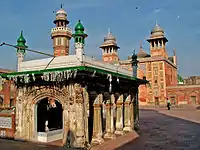瓦齊爾汗清真寺
瓦齊爾汗清真寺(乌尔都语:)是一座位於巴基斯坦旁遮普省省會拉合爾市的17世紀清真寺。清真寺在莫臥兒皇帝沙贾汉在位期間連同包括拉合尔皇家浴室等建築一併建造。清真寺在1634年開始動工建造,並在1641年完工。[2]
| 瓦齊爾汗清真寺 | |
|---|---|
| | |
 瓦齊爾汗清真寺被認為是莫臥兒風格清真寺中裝飾最豪華的一座[1] | |
| 基本 | |
| 坐标 | 31°34′59″N 74°19′24″E |
| 宗教 | 伊斯蘭教 |
| 區 | 拉合爾縣 |
| 省 | 旁遮普省 |
| 国家 | |
| 教会地位 | 清真寺 |
| 建筑详情 | |
| 建筑类型 | 清真寺和蘇非陵墓 |
| 建筑风格 | 印度-伊斯蘭風格、莫臥兒風格 |
| 奠基 | 1634年 |
| 竣工 | 1641年12月3日 |
| 詳細規格 | |
| 穹頂 | 5 |
| 外穹頂高度 | 21英尺(6.4) |
| 內穹頂高度 | 32英尺(9.8) |
| 外穹頂直徑 | 19英尺(5.8) |
| 內穹頂直徑 | 23英尺(7.0) |
| 宣禮塔 | 4 |
| 宣禮塔高度 | 107英尺(33) |
瓦齊爾汗清真寺被認為是莫臥兒風格清真寺中裝飾最豪華的一座[1],也著名於其錯綜複雜的釉陶藝術「kashi-kari」(),以及建築內部的精細的莫臥兒時代濕壁畫。在阿迦汗文化信託和旁遮普省政府的領導[3],以及德国、挪威和美国政府的協助之下[4],清真寺在2009年起進行了大規模翻新。
地理位置

清真寺位於拉合爾城牆南部一條稱為「Shahi Guzargah」的道路的附近,而該道路是以前莫臥兒貴族前往拉合尔堡皇宮的必經之路[5]。清真寺位於德里門(即清真寺的陵園的所在地以西約260米)[5]。清真寺附近是瓦齊爾汗集市廣場和奇塔门。
建造背景


清真寺是莫臥兒皇室庭園總設計師瓦齊爾汗之作[6][7][8]。瓦齊爾汗受任為旁遮普省總督後,被委託在拉合爾當地興建若干紀念建築[6]。瓦齊爾汗在奇塔门附近一帶擁有不少物業,並在1634年受委託興建瓦齊爾汗清真寺,以包圍備受崇敬的蘇非聖人塞義德·穆罕默德·以撒·格茲魯尼(,又稱米倫·伯德舍赫)的陵墓[9];該陵墓現時位於清真寺內的庭院裏[6]。清真寺原址在清真寺動工興建以前是一個老舊的聖陵[10]。
清真寺內部由鞣合了莫臥兒和旁遮普本地傳統裝飾風格的濕壁畫點綴,而外部則由波斯風格的精細釉陶藝術「kashi-kari」()大幅裝飾[11]。瓦齊爾汗清真寺取代了先前的別姬夏希清真寺成為拉合爾在主麻日的主清真寺[12]。
瓦齊爾汗清真寺是的一個較大規模的建築群(包括一個傳統上由書法店和書店進駐的商店區)的一部分,而集市廣場則位於清真寺正門的前方。[13]
瓦齊爾汗清真寺市集是南亞首個為特定目的而建造的四軸市集:其中兩軸對準了清真寺的入口,而另外兩軸則組成了「書法家市集」。[14]
除了由一系列商店所組成的「書法家市集」以外,清真寺方面也出租了寺內的一些地方給在寺內北方和東北方立面一帶經營生意的商人;清真寺方面也同時營運鄰近的夏希土耳其浴場[13][15]。由那些來源得到的收入被當成維持清真寺運作的瓦合甫(獻金)[16]。
歷史
瓦齊爾汗清真寺在莫臥兒皇帝沙賈漢的統治下於1634年或1635年開始動工,並在約七年內完工。1880年代後期,魯德亞德·吉卜林之父約翰·洛克伍德·吉卜林曾在《印度藝術期刊》()撰寫過一篇有關清真寺以及其裝飾的文章[17][18]。英國學者弗雷德里克·亨利·安德魯斯在1903年曾經提及過瓦齊爾汗清真寺曾經陷入失修狀態[19]。
參考資料
腳註
- Masson, Vadim Mikhaĭlovich. . UNESCO. 2003. ISBN 9789231038761.
- (PDF). Aga Khan Development Network. 2012 [2016-08-25]. (原始内容 (PDF)存档于2016-08-27).
The Wazir Khan Mosque was built in 1634-35 AD (1044-45 AH), by Hakim 'Ali ud din* a governor of the Punjab in the early part of the reign of the Mughal emperor Shah Jahan.
- . [2016-08-25]. (原始内容存档于2016-08-26).
The Walled city of Lahore is famous for several historic monuments including the Lahore Fort – a World Heritage site, the Badshahi and Wazir Khan mosques. Close to 2,000 buildings within the Walled city display a range of architectural features that mark Lahore’s centuries old cultural landscape. A majority of these buildings and the mohallas (local neighbourhoods) in which they are situated form a unique heritage footprint. The work consequently carried out by the Aga Khan Trust for Culture (AKTC) and the Aga Khan Historic Cities Programme (AKHCP) was initiated under a 2007 public-private partnership framework agreement with the Government of Punjab.
- Muzaffar, Zareen. . The Diplomat. 2016-02-08 [2016-08-25]. (原始内容存档于2016-08-29).
The Walled City of Lahore program was put into effect in partnership with the Aga Khan Trust for Culture. AKTC supports the Walled City Authority in all technical matters in terms of restoration and conservation work being carried out. Other donors include the World Bank, Royal Norwegian Government, USAID, and the German Embassy.
- . Aga Khan Historic Cities Programme. Aga Khan Cultural Services - Pakistan. 2012 [2016-08-25]. (原始内容存档于2016-08-27).
- Asher, p.225
- Goitein, Shelomo Dov. . BRILL. 2010: 170. ISBN 9004179313.
- . Archnet. [2016-08-25]. (原始内容存档于2016-08-27).
The mosque was founded by Hakim Ilmud Din Ansari, a distinguished physician from Chiniot who received the Ministerial title of 'Wazir Khan' under the reign of Shah Jahan, and was later promoted to the position of Viceroy of Punjab.
- Westcoat, p.160
- (PDF). Aga Khan Development Network. 2012 [2016-08-25]. (原始内容 (PDF)存档于2016-08-27).
It was built on the remains of an old Sufi complex and the Sufi grave sites associated with it.
- Wescoat, James. . Dumbarton Oaks. 1996: 160.
- Gharipour, p.87
- . Aga Khan Development Network. [2016-08-25]. (原始内容存档于2016-08-26).
The complex included the mosque itself, the chowk (an urban introductory space), a row of hujras (shops) integrated in the entrance system meant specifically for calligraphers and bookbinders, and additional shops on the eastern and northern facades built into the body of the monument.CURRENT PROJECTS
- Salman, Muhammad. (PDF). Aga Khan Cultural Service. Aga Khan Cultural Service. [2016-08-25]. (原始内容 (PDF)存档于2015-11-23).
- . Aga Khan Historic Cities Programme. Aga Khan Cultural Services - Pakistan. 2012 [2016-08-25]. (原始内容存档于2016-08-27).
The spectacular monumental ensemble of the Wazir Khan Mosque in the Walled City of Lahore was built in 1634 during the reign of the Mughal emperor Shah Jahan. Its endowment then comprised the congregational mosque, an elaborate forecourt, a serai, a hammam, a bazaar, and a special bazaar for calligraphers and bookbinders.
- Qasmi, A. H. . Gyan Publishing House. : 269. ISBN 9788182053205.
- . umedia.lib.umn.edu. [2019-03-19]. (原始内容存档于2017-08-04).
- . Journal of Indian Art (1886 and 1887) (London: W. Griggs and Sons). [2019-03-19]. (原始内容存档于2018-09-05).
- Mumtaz, Kamil Khan. . Islamic Arts. [2016-08-26]. (原始内容存档于2016-06-22).
參考書籍
- Asher, Catherine Blanshard. . Cambridge University Press. ISBN 9780521267281.
- Gharipour, Mohammad. . Routledge. ISBN 9781317548225.
- Wescoat, James L. . Dumbarton Oaks. ISBN 9780884022350.
- Haig, Wolseley. . CUP Archive.